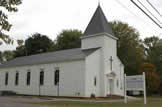 |
|
Cowan Methodist Church: 1947-1962By L. Jarod Pearson Click here to read about Cowan Methodist Episcopal Church (1842-?), predecessor to Cowan Methodist Church. Methodist churches and small town rural America go hand-in-hand. It seems that every small town and every rural farming community, from one end of the country to the other, has a Methodist church. In fact, there are far more Methodist churches in the United States than there are Post Offices! Considering the impact of Methodism in the pioneer settlement of early America, it seems rather strange that Cowan, Tennessee existed for at least eight decades without a Methodist Church! The first church to be organized in Cowan was Boiling Fork Baptist Church, which was built in 1822 and located where Miller Branch meets Boiling Fork Creek. An equal portion of Cowan's population, however, attended Goshen Cumberland Presbyterian Church, about a mile-and-a-half west of Cowan and also located on Boiling Fork Creek. (Goshen was organized in 1810 and is Franklin County's oldest church.) It wasn't until 1842 that the first attempt was made to organize a Methodist Church in Cowan, and that congregation disbanded not long afterward, presumably due to the Civil War. Eight decades passed before another attempt was made to organize a Methodist church in Cowan. In May, 1947 a Rev. Cullen T. Carter, Conference Extension Secretary, made an exploratory visit to Cowan. At that time, Cowan was a thriving community with strong industry and commerce. The town population was also approaching a peak level. Rev. Cullen's visit concluded that Cowan needed a Methodist congregation and had the means to support one. Immediately after Rev. Carter's visit a new congregation began meeting at Cowan Public School with the first service held on Sunday, June 8, 1947. That same year, a piece of land only one block from the school was deeded to the congregation by Mr. Ben Heikens. The newly organized congregation did not have the financial resources to build a new worship facility, but there was an imminently more practical solution in the works. At the conclusion of World War II, Camp Forrest in nearby Tullahoma was being dismantled and redeveloped for other military and research purposes. At a public auction, Cowan residents were able to purchase the old army chapel and have it moved from Camp Forrest to the donated Heikens property in Cowan. This not only provided Cowan Methodists with an affordable worship space, but a very attractive one as well. Cowan Methodist Church, meeting in the old army chapel, formally organized on April 14, 1948. The congregation grew from the original 36 founding members to eighty-six members in only five years. The immediate success of the new church only begged the question why Cowan went so long without a Methodist Church! As with most small towns, Cowan began to change in the latter half of the 20th-Century. The growth of the automobile and the decline of railroad transportation took its toll on Cowan. Membership in Cowan churches began to decline as the area population depleted and demographics changed. In 1962 the leadership at Cowan Methodist Church took note of the present situation. With any further decline, the church would no longer sustain itself. A few streets over, Cowan Presbyterian Church found itself in a similar position. Members of both congregations entered into formal discussions about the possibility of a federated church and commissioned a feasability study. The study found that there were already meaningful friendships between the two churches, some family kinships, and even some professional relationships. Bringing these two congregations together under one roof would not be easy, but at the same time would not be difficult. On June 17, 1962, both congregations voted overwhelmingly to federate. Cowan Methodist Church applied to the Bishop and District Superintendent of the Methodist Conference for permission to federate while Cowan Presbyterian sent a similar application to the Executive of Nashville Presbytery. Both regional church bodies had to consult with colleagues and with the respective national church organizations. After further study at all levels, a process was laid out for the two congregations to come together. Each had a stipulation that the two congregations retain their own affiliation and identity while sharing the responsbilities of church government.
The merged congregation was named Cowan Fellowship Church. Initially, Cowan Fellowship met in the Presbyterian facility and used the Methodist building as a youth building. In 1966, the Presbyterian building was sold to a newly organized Church of God congregation, and Cowan Fellowship moved in to the Methodist building entirely. A building committee, formed in 1967, raised funds to build a modern new church facility on a piece of land donated by Mr. Glenn Hines. The building was completed in 1969. Although no longer a seperate congregation, Cowan Methodist Church still exists. By design and constitution the Cowan Fellowship Church has a functioning Methodist congregation with an elected governing board and an active presence in the regional United Methodist annual conference. The board works side-by-side with the elected session of the Presbyterian congregation. Click here to read about Cowan Fellowship Church, the successor to Cowan Methodist Church. Information for this article was gathered from the writings of Jim and Jenny Lou Brock, Emeline Gist, and Mrs. Violet Wakeland.
|
